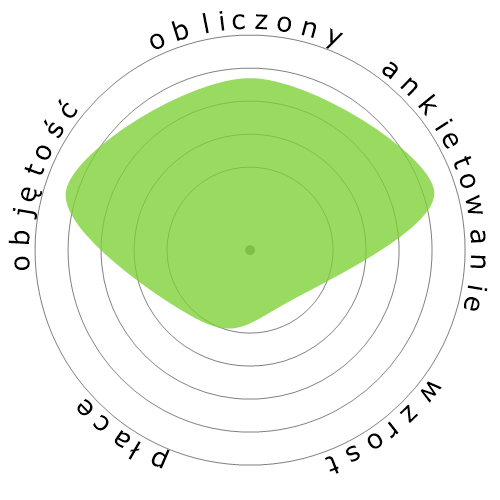Licencjonowani praktyczni i zawodowi pielęgniarze/pielegniarki




Ludzie również oglądali
Obliczone ryzyko automatyzacji
Niskie ryzyko (21-40%): Zawody na tym poziomie mają ograniczone ryzyko automatyzacji, ponieważ wymagają połączenia umiejętności technicznych i skoncentrowanych na człowieku.
Więcej informacji na temat tego, czym jest ten wynik i jak jest obliczany, jest dostępne tutaj.
Ankieta użytkownika
Nasi goście zagłosowali, że jest małe prawdopodobieństwo, iż ten zawód zostanie zautomatyzowany. To ocena jest dodatkowo wspierana przez obliczony poziom ryzyka automatyzacji, który szacuje 24% szansę na automatyzację.
Jakie są Twoje zdanie na temat ryzyka automatyzacji?
Jakie jest prawdopodobieństwo, że Licencjonowani praktyczni i zawodowi pielęgniarze/pielegniarki zostanie zastąpione przez roboty lub sztuczną inteligencję w ciągu najbliższych 20 lat?
Wzrost
Liczba ofert pracy na stanowisku 'Licensed Practical and Licensed Vocational Nurses' ma wzrosnąć 2,6% do 2033
Całkowite zatrudnienie oraz szacowane oferty pracy
Zaktualizowane prognozy mają być dostępne 09-2025.
Płace
W 2023, mediana rocznej pensji dla 'Licensed Practical and Licensed Vocational Nurses' wynosiła 59 730 $, czyli 28 $ za godzinę.
'Licensed Practical and Licensed Vocational Nurses' otrzymali wynagrodzenie wyższe o 24,3% od średniej krajowej, która wynosiła 48 060 $
Płace z biegiem czasu
Objętość
Od 2023 roku zatrudnionych było 630 250 osób na stanowisku 'Licensed Practical and Licensed Vocational Nurses' w Stanach Zjednoczonych.
To oznacza około 0,42% zatrudnionej siły roboczej w całym kraju.
Inaczej mówiąc, około 1 na 240 osób jest zatrudnionych jako 'Licensed Practical and Licensed Vocational Nurses'.
Opis stanowiska pracy
Opieka nad chorymi, rannymi lub rekonwalescentami, a także osobami niepełnosprawnymi w szpitalach, domach opieki, klinikach, prywatnych domach, domach grupowych i podobnych instytucjach. Praca może odbywać się pod nadzorem pielęgniarki dyplomowanej. Wymagane jest posiadanie licencji.
SOC Code: 29-2061.00


Komentarze
As an example, take the humanised skill of empathy. Empathy is the emotional skill to understand and share the feelings of another person. This shared emotional connection is something many, if not all, patients crave and desire. Empathy is something that AI cannot replicate well. In order for empathy to occur between two individuals, both individuals must be capable of emotions. Humans are capable of emotions, but AI robots are not. Emotions are biological, chemical, and mental reactions to certain stimuli. These reactions are uniquely inherent to organic living biological beings. An AI robot is not an organic living being, and thus cannot produce emotions. The best an AI can do is be programmed in a way to say certain things when a patient exhibits particular facial responses or verbal/tonal nuances. However, there is more to empathy than just being responsive. There exists a shared feeling that a human can only feel with another human, or another animal, especially when one of those humans is in a medically ill or injurious state.
Critical thinking serves as another example of a humanised skill that AI will find difficult to replicate. Critical thinking is the intellectual act of considering certain concepts, and constructing a charitable and objective take on said concepts through abstract reasoning or empirical evidence. To further this, the more unique and nuanced those concepts are, the more difficult it will be to critically think about said concepts. In the healthcare settings that LVNs find themselves in, there exists many unique concepts, or in this case, situations. I will illuminate one and that would be the case of patients with severe dementia. Patients with this mental condition may showcase behaviour that includes, but not limited to, loud screaming, random crying and potential desires for killing. What to do with these kind of patients is something LVNs face on a daily basis. Should the LVN just ignore the patient? Doing so may endanger the patient to him or herself, or worse, endanger other patients situated in the same room. Ignoring patients is also considered abuse in healthcare settings. On the other hand, ignoring the patient may allow the LVN to give care to other patients with much more debilitating conditions in the meantime, and thus allowing the LVN efficient time management. The LVN can also attend to that patient first, but only to administer medication that will calm him down, and make the LVN’s work less difficult. This may prove detrimental, if a family member of another patient asked the LVN to administer medicine to him first, because he missed a dose earlier in the day. With all this in mind, one can see how as an LVN there are many factors that they have to consider when making a reasonable decision, such as proper ethics, personal feelings, logical order of work, and so on. The LVN must be able to evaluate these factors and utilise his intellectual capacity for reason to support making the right decision. An AI’s intellectual capacity is much more rigid than a human’s mind. An AI robot cannot improvise at any given moment in the same fashion as a human. Unique situations, such as the aforementioned dementia case, requires a mind being able to asses many nuanced factors unique to the situation. Unfortunately, AI is just not capable yet of such critical thinking.
Zostaw odpowiedź na temat tego zawodu